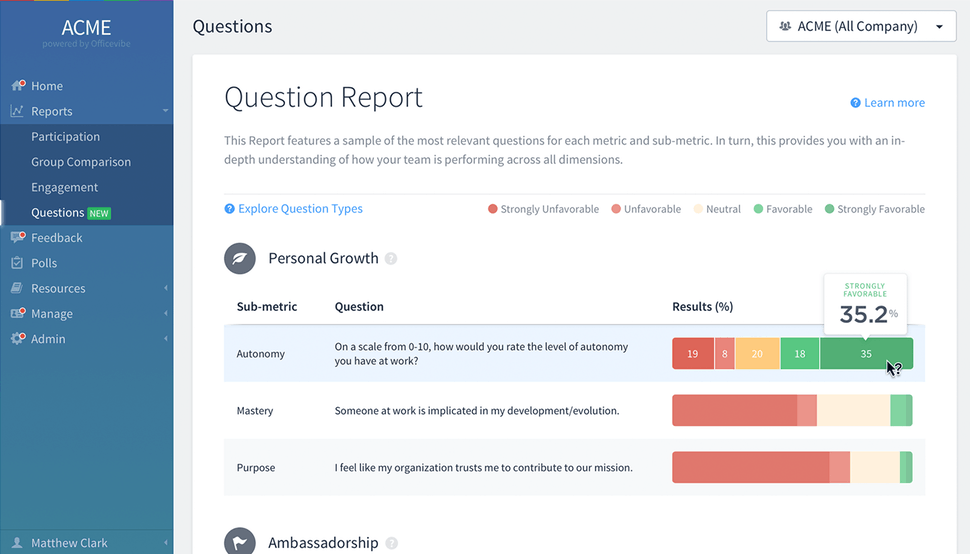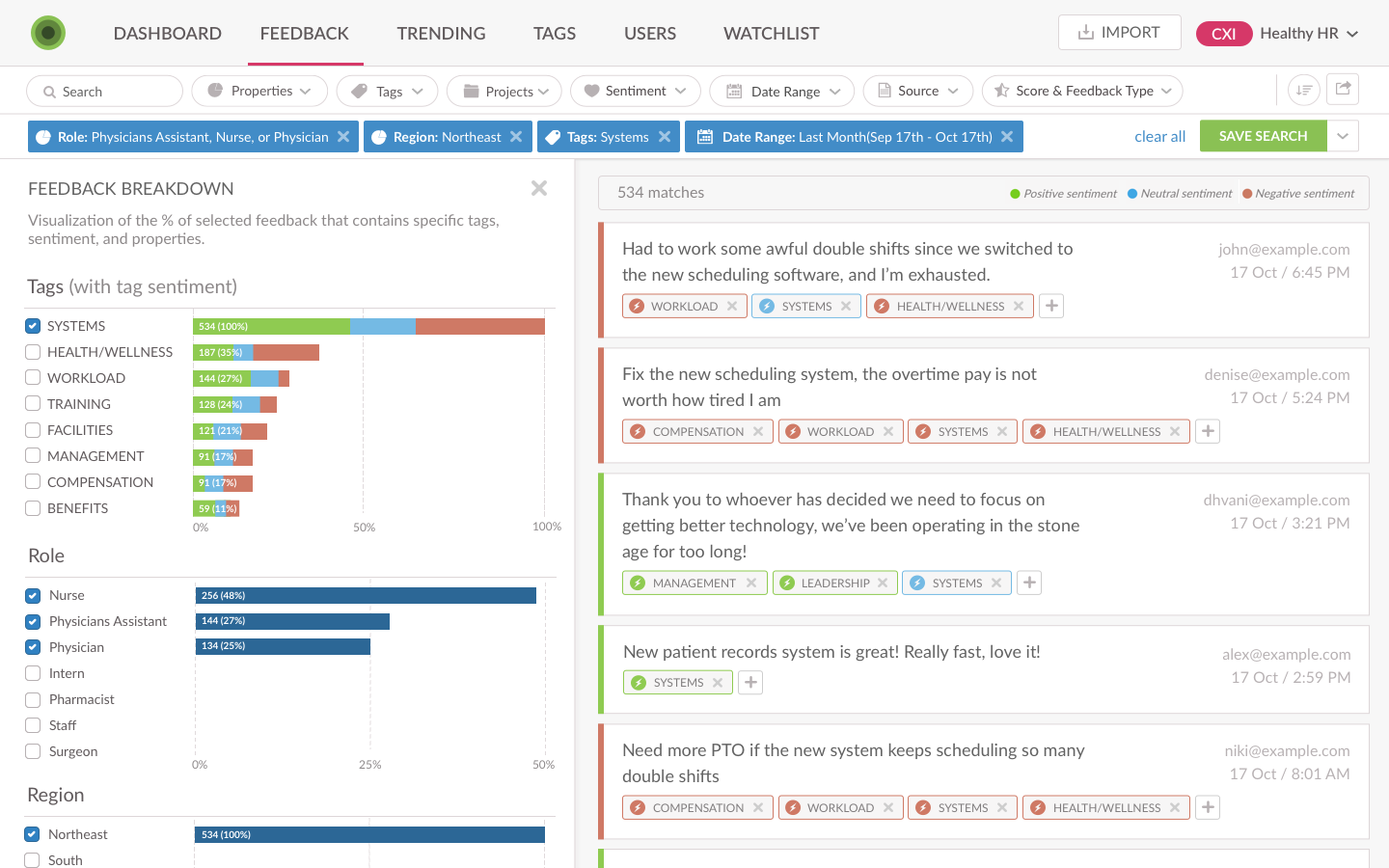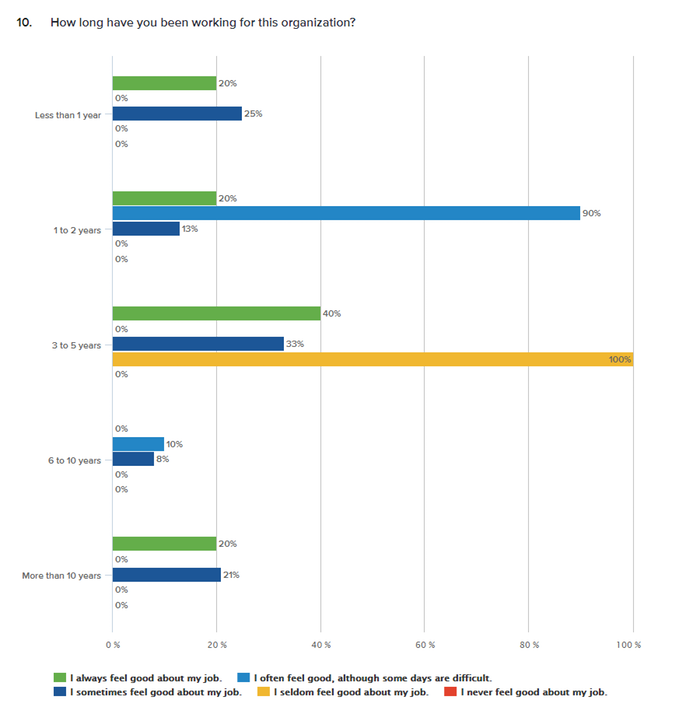What to Do With Employee Engagement Survey Results
You’ve run your employee engagement survey and the results are in. At a glance, your overall engagement scores might paint a pretty picture. Or they show that there are some glaring red flags across your organization.
Whether you’re pleasantly surprised by the overall results or thrown by negative feedback you weren’t expecting, here’s the worst thing you can do: Do nothing with the data. Asking employees to give you feedback only to ignore it is a surefire way of quickening your employees’ disengagement.
The success of driving engagement initiatives in your organization depends on what you do with these employee survey results. Whether this is your first or hundredth employee engagement survey, we’ve got the lowdown on how to identify, prioritize, and communicate an action plan that drives positive change across your organization.
Employee engagement analysis: Which results matter most?
It’ll be tempting to look at your results and think, “In which areas are employees most positive and negative?” and base the rest of your survey analysis on those glaringly obvious, high-level results.

Example of an engagement survey data report in Officevibe (Source)
But here’s the thing: It’s a mistake to only focus on high-level results from across the board, instead of segmenting your results data into more granular, meaningful detail. Unless the data is broken down into more insightful employee segments, you won’t be able to accurately identify your organization’s strengths and weaknesses, department by department, employee by employee.
For example, if you see that 80% of your workforce reports that they’re happy about coming to work every day, it’s easy to overlook the fact that 20% of your workforce isn’t happy about their workplace environment. This overall result looks favorable, but there’s more that lies beneath this one figure.

Employee feedback segmentation in Wootric’s employee feedback platform (Source)
Employee engagement tools can help you get granular with the rich information you have and help you pinpoint exactly which teams and/or managers are struggling with certain workplace issues. Let’s say that your recent survey showed that 80% of overall respondents believe that their manager effectively communicates their goals with them. However, when you break that down further into segments, you see that 90% of your development team agrees that their manager effectively communicates with them, while only 35% of your sales team agrees.
This signals that there’s a disconnect between the way your sales manager and your development manager communicates with their respective teams—suddenly that 80% overall response doesn’t feel so settling.
Key points to remember:
Don’t focus on the obvious highlights and lowlights. Drill down deeper into the data to find out exactly where engagement initiatives can make a real difference, and if you have them, compare the most recent results with previous ones to track trends over time.
Employee engagement survey results benefit both you and your employees. The analysis of your survey results presents a timely opportunity to see how your employees are thinking and feeling about the organization. This gives you a huge opportunity to increase engagement by improving in the areas where employees feel the company is lacking. In turn, this fosters employee engagement, which also has been shown to improve employees’ overall productivity.
Employees are each motivated by different things. When analyzing your survey results, try to avoid making blanket assumptions, as this will lead to implementing blanket solutions. Each team, department, and individual will have different motivators and demotivators, and it should be your goal to drill into the data and work out what those are.
Turn insights into actions: How to prioritize specific engagement actions
Now that you’ve identified where your organization’s weak spots lie, it’s time for your HR department and your departmental managers to prioritize where exactly to invest in engagement initiatives.
While data-driven insights make it easier to pinpoint where improvements can be made, it’s up to you to decide how exactly to prioritize the changes. This will largely depend on the size of your organization and the type of industry that you’re in.
Employee engagement platforms can assist with cross-tabulating data to help with prioritizing your action plans. However, we recommend that you begin high-level prioritization by grouping your engagement actions into two separate categories:
Manager-level actions, such as ideating plans for improving team-level employee recognition initiatives and improved career and development plans.
Organizational-level actions, such as ideating actions for developing improved flexible working policies and company culture initiatives.

An example of cross tabulated employee engagement survey data in SoGoSurvey (Source)
Once your results have been grouped into these two categories, you can divide the action planning focus between two distinct groups who have the best insight into how to best prioritize actions to be taken. This will also help management teams to understand what the results mean for their own teams.
Best practices for prioritizing actions to be taken:
Designate a lead for each part of the action plan. They will be responsible for enacting the action plan as well as setting deadlines and milestones. Having a “project lead” who is accountable to the rest of the team ensures that changes are being put into place.
Identify “low-hanging fruit.” Low-hanging fruit, or “quick wins,” are the actions that can be achieved most easily with the minimal resources and time that is necessary for implementation. This gives employees confidence that you’ve listened to their feedback and that you’re committed to continuing on that path.
Pinpoint areas where there’s a great amount of consensus. Similar to low-hanging fruit, some results reveal that an overwhelming majority of employees are feeling the same way about a certain topic. These are typically areas where your actions can make a huge difference to their daily working lives.
Communicate employee survey results and actions to staff
Arguably, the most important part of this process is communicating the results and the actions you have planned to address engagement issues. Though this seems obvious, 20% of managers aren’t sharing the results of employee engagement surveys with their employees.
Once you’ve identified your priorities and actions to be taken, hold a meeting with your entire workforce to communicate organization-wide results and actions. Then enlist your individual departments and team managers to go through the results on a more granular scale with their direct reports.
Follow these steps to effectively communicate survey results and pending actions to your workforce:
Give an overview of the overall top-line survey results, highlighting where the organization has excelled in the eyes of employees, and acknowledging where employees have identified areas for improvement. You can also break out the results by theme, if it’s helpful to do so. For example, our article on employee engagement survey themes breaks down five survey themes, including “workplace and resources” and “job fulfilment.”
Highlight how each area for improvement represents an opportunity for the leadership to strengthen the organization’s performance in its strategic priorities and objectives. For example, if employees have indicated that there are too many convoluted processes getting in the way of them completing their tasks, then they’re likely being less productive. Let them know you’ll conduct a process review to assess which procedures do and don’t add value.
Let employees know how you came to agree on the actions you’re going to take as an organization and that not all actions can be implemented right away. Inform them that your leadership teams will continue to work on solutions.
Finally, communicate which actions are going to be taken immediately and those that will take more time to flesh out. Take time to explain their intended impact, and leave an appropriate amount of time for employees’ questions.
Lastly, you want to make sure you’re following up on engagement actions. The easiest way to do this is by sending out periodic employee pulse surveys. These will help you gauge how your action items are resonating with your employees and help you make adjustments if needed.
You have an employee engagement action plan! What’s next?
Keeping the momentum to follow through on survey actions is critical to sustaining employee engagement levels. Many organizations view employee engagement surveys as a one-off “must-have” HR exercise, but those that understand the value of employee insights will enjoy improved performance levels across the organization.
Rely on your HR team to help supervise the ongoing process of developing employee engagement plans—working with HR will help refine action plans in line with company policy. Remember, the more time you spend working to refine actions based on data, the more your organization will develop strong skills in enacting positive change.
If you’re already thinking about your next employee engagement survey and its following plan, check out employee survey solutions that can also suggest improvements and actions for your organization based on the survey data. Or chat with one of our software advisors who can help you find software with additional data analysis functionality.
Note: The applications selected in this article are examples to show a feature in context and are not intended as endorsements or recommendations. They have been obtained from sources believed to be reliable at the time of publication.